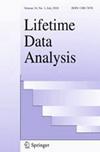评估有和没有筛查史的癌症风险。
IF 1
3区 数学
Q3 MATHEMATICS, INTERDISCIPLINARY APPLICATIONS
引用次数: 0
摘要
基于一个人的当前年龄和使用疾病进展模型的筛查史,开发了一种估计无症状个体余生癌症风险的概率方法。风险是从无病到临床前状态的转移概率密度、临床前状态的停留时间和筛查敏感性(如果有筛查史结果为阴性)的函数。这种方法适用于任何慢性疾病。以该方法为例,在有筛查史和无筛查史两种情况下,利用大纽约健康保险计划(Health Insurance Plan of Greater New York)估算的参数对女性乳腺癌风险进行了估计,并获得了一些有意义的结果。本文章由计算机程序翻译,如有差异,请以英文原文为准。
Estimating the risk of cancer with and without a screening history.
A probability method to estimate cancer risk for asymptomatic individuals for the rest of life was developed based on one's current age and screening history using the disease progressive model. The risk is a function of the transition probability density from the disease-free to the preclinical state, the sojourn time in the preclinical state and the screening sensitivity if one had a screening history with negative results. The method can be applied to any chronic disease. As an example, the method was applied to estimate women's breast cancer risk using parameters estimated from the Health Insurance Plan of Greater New York under two scenarios: with and without a screening history, and obtain some meaningful results.
求助全文
通过发布文献求助,成功后即可免费获取论文全文。
去求助
来源期刊

Lifetime Data Analysis
数学-数学跨学科应用
CiteScore
2.30
自引率
7.70%
发文量
43
审稿时长
3 months
期刊介绍:
The objective of Lifetime Data Analysis is to advance and promote statistical science in the various applied fields that deal with lifetime data, including: Actuarial Science – Economics – Engineering Sciences – Environmental Sciences – Management Science – Medicine – Operations Research – Public Health – Social and Behavioral Sciences.
 求助内容:
求助内容: 应助结果提醒方式:
应助结果提醒方式:


